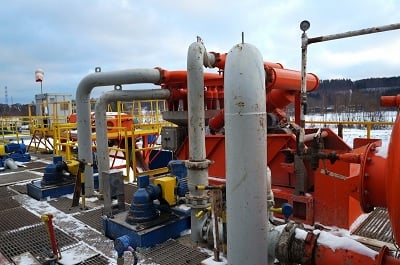
Associated gas and natural gas liquids (NGLs) are valuable commodities, and to realize profits special care is required during winter months.
Upstream pipelines are designed to handle a nominal amount of liquid or transport what is referred to as two-phase flows, liquid and gaseous hydrocarbons. As temperatures drop, two fluid properties come into play that must be addressed to maintain the viability of oil and gas infrastructure: the dew point and the hydrocarbon dew point (HDCP).
A gas mixture's dew point is the temperature at which it becomes saturated with water content. As temperature drops below the dew point, water condensation occurs, which increases the oxidation potential. Water and hydrocarbon are also immiscible fluids, meaning that they do not form a homogeneous mixture. This further complicates fluid flow regimes.
The hydrocarbon HCDP of a gas mixture is the temperature at which natural gas liquids start to condense out of the gaseous phase. As temperatures drop, this phenomenon leads to increased liquid hold-up volumes. Excess liquids are prone to plugging pipelines, valves, instrumentation and ultimately prevent fluid flow.
The dew point of a gas mixture and HCDP both are functions of temperature, pressure and gas composition. It is not economically viable to heat large fluid volumes and pressure needs to be maintained at certain levels in order to promote fluid flow. Left untreated, the mixture of NGL and water is also increasingly susceptible to gas hydrate formations, which may block and damage or destroy oil and gas infrastructure. This leaves only one viable solution, gas treatment technologies.
Gas treatment technologies
One effective way to maintain gas dew points is to treat gas at or near the wellhead. No single most-effective technology exists; instead, several treatment types collectively help producers manage the dew point and HCDP. To manage these factors and prevent gas hydrates from forming, either water or natural gas liquids are removed from the produced fluids.
Dry gas is a gas mixture of hydrocarbons with a lower molecular weight. These lighter hydrocarbons have a much lower HDCP and are easily transported through a pipeline. Wet gas (also referred to as high BTU gas), has nothing to do with water content but describes a gas with heavier hydrocarbons. Wet gas has a higher HDCP and is often highly valued for NGL production.
A passive dehydration system is effective at removing water content from both dry and wet gases. These desiccant dehydration systems remove excess moisture and are most often used at compressor stations and in fuel lines.
A second method of treating natural gas is to remove NGL. This is typically accomplished by a Joule-Thomson system. These self-refrigeration systems push the gas stream through a valve. As the gas stream exits the valve it expands, creating a cooling effect. The temperature drop allows heavier hydrocarbons to condense. These are then stored in a holding tank or are otherwise separated from the gas stream.
Gas dehydration and Joule-Thomson systems collectively act to treat gas and meet prescribed gas pipeline specifications. These systems are considered to be vital components of oil and gas infrastructure during winter months.